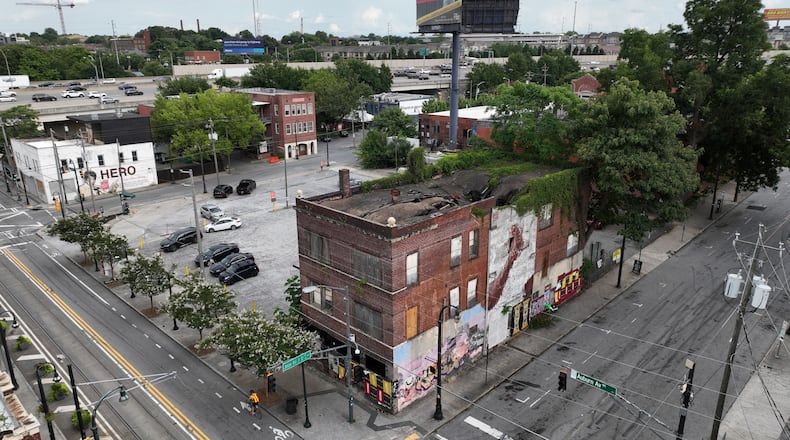When a tornado ripped through Atlanta’s historic Auburn Avenue in 2008, knocking down the then-83-year-old Herndon Building, it miraculously spared the Atlanta Life Insurance branch office building next door.
Barely.
The tornado showed the three-story brick building, which was already abandoned, little mercy.
The wind and rain battered 229 Auburn Ave., built in 1908, beyond reasonable repair in the eyes of developers.
But it kept standing and the collapse of the Herndon Building next door exposed the long-forgotten, but racially insensitive, Gold Dust Twins Soap mural that had been hidden since 1925. Recent research suggests the crippled building also housed Georgia’s first Black-owned bank.
Now, it finds itself in the middle of a battle between history and progress, which could determine the immediate future of Auburn Avenue.
Credit: arvin.temkar@ajc.com
Credit: arvin.temkar@ajc.com
The Butler Street Community Development Corporation wants to tear down the building to make way for a multimillion-dollar affordable housing complex that could change the face of the avenue that today barely resembles what was once called “the richest Negro street in the world.”
But local conservationists, led by David Yoakley Mitchell, executive director of the Atlanta Preservation Center, are fighting the pending demolition to save one of the last remnants of Auburn Avenue’s rich history.
“This space has been in this community for more than 100 years. I don’t see any reason why it can’t do another 150,” Mitchell said. “Auburn Avenue has been a space that we have pulled from since Martin Luther King’s passing. I think it is fair to put something back in it.”
Jerome Edmondson, a member of the Butler Street CDC’s board, has heard all of the arguments, but was blunt about the future of the building.
“The plan is to tear it down,” Edmondson said.
Credit: arvin.temkar@ajc.com
Credit: arvin.temkar@ajc.com
The fight over 229 Auburn Ave. comes at a crucial time.
Community leaders are banking on an influx of federal aid through the infrastructure bill to address communities destroyed by the construction of highways through mostly Black neighborhoods.
Although there are pockets of redevelopment in the Old Fourth Ward, anchored by the Martin Luther King Jr. Historical District, Auburn Avenue has been struggling for years.
Whole blocks are still lined with crumbling and boarded-up buildings, a far cry from the days when the corridor nurtured a rising Black middle class, including the King family, as well as a concentration of Black-owned businesses, a Black-run daily newspaper and several major social justice organizations.
In 2021, the National Park Service, which oversees the King Historical District, released a study of the area showing that nearly half of the buildings that were there 45 years ago — when the secretary of the interior designated the street and some of its surroundings as the Sweet Auburn National Historic Landmark District — are gone due to tornado damage, new construction and neglect.
Credit: HYOSUB SHIN / AJC
Credit: HYOSUB SHIN / AJC
Many of the buildings were constructed between the end of the Civil War through the mid-1930s. The Atlanta Life Insurance branch office is the last remaining building from the Herndon Building block. The rest of the land is a parking lot.
Matt Adams, interim assistant director of the city’s Office of Design and Historic Preservation, said the owners of 229 Auburn Ave. have received approval to secure demolition permits, but that does not automatically grant permission for a property to be demolished.
Because it is in the King District, it “has protection against unnecessary demolition,” meaning that the owners still have to apply for a special permit and prove that demolition is the only reasonable remedy against threats to public health and safety or unreasonable economic return, Adams said.
Alfonza Marshall, chairman of the Butler Street CDC, said it could take another six months to a year before final plans for the new apartment complex are nailed down. Plans also include retail, community and office spaces, a restaurant, and a new park dedicated to former congressman and civil rights leader John Lewis, who died in 2020.
“A project of this undertaking, in one of the most sacred historical districts in America, takes some time to put together,” said Marshall, adding it could be “a catalyst for revitalization and growth.”
Mark McDonald, chief executive of the Georgia Trust for Historic Preservation, said his organization would be available to work with the Butler Street CDC and The Atlanta Preservation Center to come up with a solution.
“The Atlanta Life Insurance building at 229 Auburn Avenue represents African American achievement and enterprise in the Jim Crow era,” McDonald said. “Every effort should be made to preserve this important 1908 structure so that it can be an inspiration to current and future generations.”
Credit: Library of Congress
Credit: Library of Congress
NPS spokesperson Saudia Muwwakkil said the loss of the building “could further diminish the district’s historic integrity” and that the federal agency “will continue to monitor related project proposals with an eye toward continued preservation of this nationally significant community.
While being in the Sweet Auburn National Historic Landmark District offers national recognition, access to technical assistance and eligibility for grants, the buildings are not inherently protected from being altered or torn down, as property owners still have the right to do whatever they want to their property.
No other buildings along Auburn Avenue are being discussed for demolition.
On a recent day, Edmondson and Mitchell found themselves on the southeast corner of Auburn Avenue and Jesse Hill Jr. Drive at the same time, but didn’t notice one another.
Mitchell was in front of the building preparing to lead a tour through the neighborhood. Edmondson was around the corner doing interviews in the parking lot beneath the John Lewis HERO Mural, which will soon be a new urban park.
Mitchell was promoting the past. Edmondson, the future.
Credit: arvin.temkar@ajc.com
Credit: arvin.temkar@ajc.com
The preliminary plan calls for about 100 brand new apartment units with about 80 of them scheduled to be priced as affordable to households making between 30% and 60% of the area’s median income.
The Butler Street CDC, a nonprofit formed in 2013 to manage the redevelopment of properties owned by historic the Butler Street YMCA, has been trying to develop the area around the old YMCA and the Walden Building for about eight years.
One of the major hurdles has been the fate of 229, which would cost between $8 million and $10 million to restore and has scared off developers.
“I understand and appreciate what the preservation folks are talking about. I know there are different properties that give the Sweet Auburn area its historic value and when you remove one of those properties, you take away from that value,” Edmondson said. “But we can’t grow and become a better community if the history is just a building.”
Credit: arvin.temkar@ajc.com
Credit: arvin.temkar@ajc.com
Mitchell said that is the exact point.
Calling it “demolition by neglect,” Mitchell said that Black people have owned the space where the building is occupied since the 1870s. Aside from being a branch office of Atlanta Life, Mitchell said that a new round of research by Sarah Borcherding, a graduate student in Georgia State University’s Heritage Preservation Program, uncovered that from 1910 to 1913, the building housed the Atlanta State Savings Bank, the first Black banking institution in Georgia.
The building has also at times been the home of several Black-owned businesses like a restaurant, funeral home, beauty college, an accounting school, a tailor and the Atlanta Dance Theatre.
Atlanta Life Insurance moved into the building in 1926.
Credit: The Herndon Home
Credit: The Herndon Home
“They did stuff that was very courageous from this very small building, so it is extremely important that we hold our ground. This building’s significance continues to grow as we do our research,” Mitchell said. “This isn’t on some dirt road. This is on Auburn Avenue, next to the Butler Street YMCA. This is pretty big.”
Mitchell has been inside the long-abandoned building and admits that it is “challenged.” Standing outside of it, the wind waved the leaves of giant tree-like weeds over Mitchell’s head. Looming larger is the faded mural of “Goldie” and “Dusty,” the original pickaninny Gold Dust Twins, that Fairbanks Gold Dust washing powder used as advertising mascots more than 100 years ago.
“It is not our intention to prevent the development of a vacant lot, but rather to incorporate this building into the development through adaptive reuse,” Mitchell said. “I have no interest in seeing their efforts being thwarted. I just want to see this building incorporated into this project when it is completed. That is fair.”
Credit: Daniel Varnado
Credit: Daniel Varnado
Mitchell’s office is headquartered in Grant Park’s 166-year-old Lemuel P. Grant Mansion, one of the oldest houses in Atlanta, that was once abandoned and scheduled for demolition. But if the Butler Street CDC is looking for an example of adaptive reuse, they can just walk down Auburn Avenue.
When the 2008 tornado marched down Auburn Avenue, it also nearly destroyed the old Atlanta Daily World Building, tearing the roof off of the headquarters of the nation’s first Black daily newspaper.
In 2015, Gene Kansas, a local developer unaffiliated with the 229 project, redeveloped the building, built in 1912, into a small mixed-use building with a coffee shop on the bottom and a media company and two apartments on top.
“The people who wanted it torn down came up with a lot of reasons. But now that building is thriving,” said Kansas, who also owns and redeveloped the shared workspace Constellations on Auburn Avenue. “Sweet Auburn has a magical quality. If the buildings are no longer standing, we might lose our way. The future generations will not learn the lessons.”
About the Author
Keep Reading
The Latest
Featured





